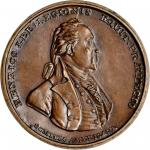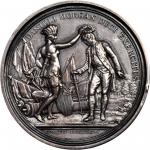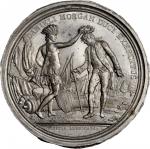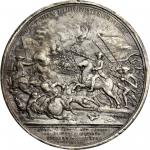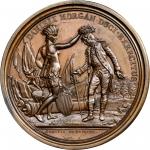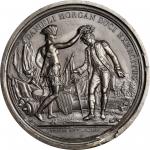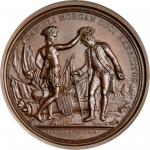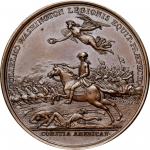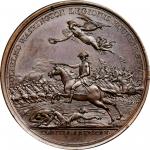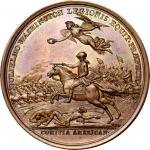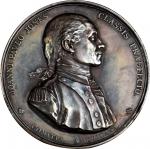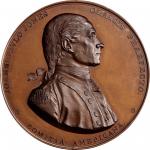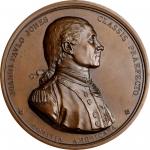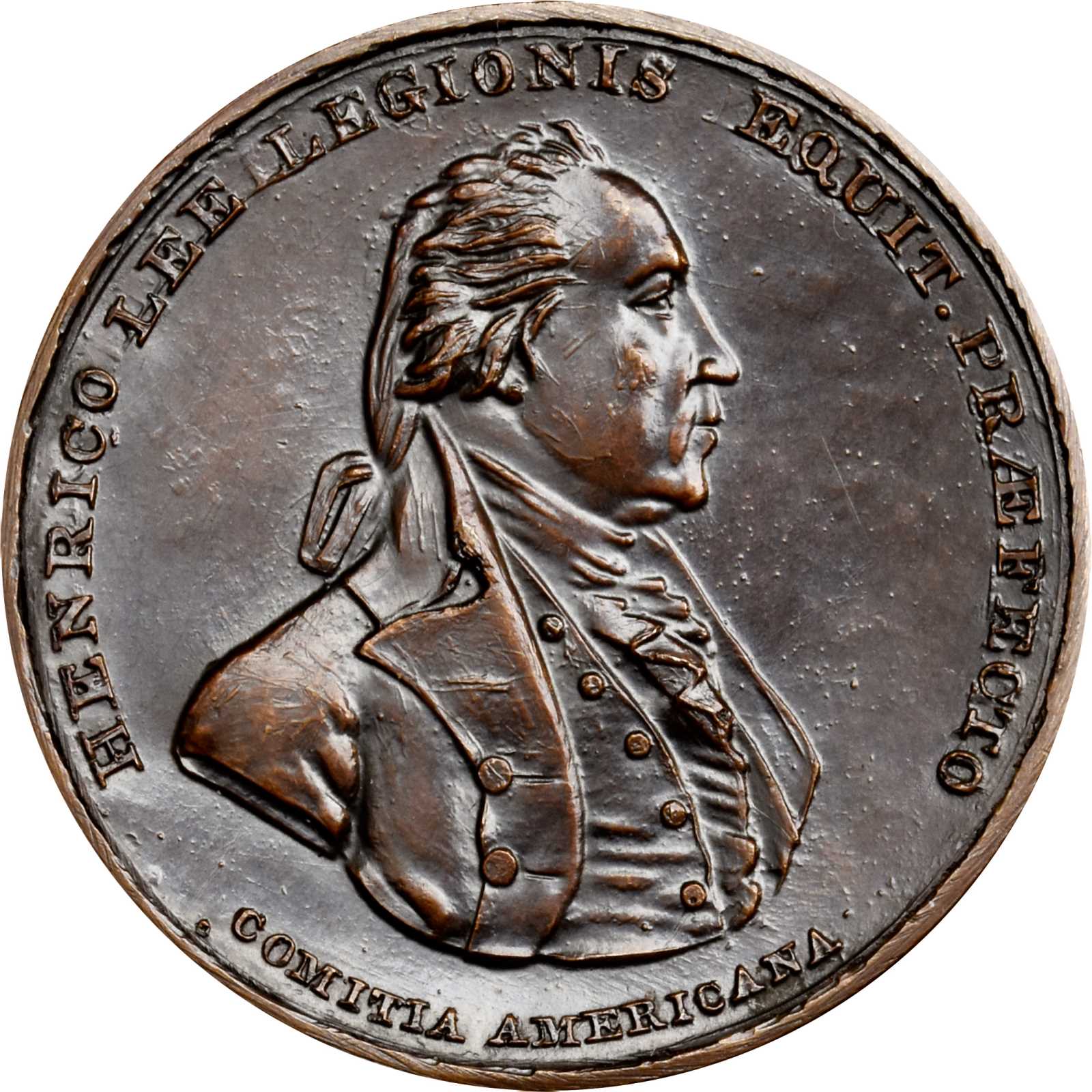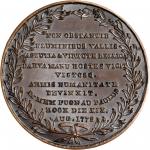1779 (ca. 1848) Henry Lee at Paulus Hook fantasy electrotype. As Betts-575, As Julian MI-5. Joined electrotype copper shells. Unknown American workshop. 44.4 mm, 541.1 grains. 4.1 - 4.4 mm thick. Nearly as made.Square filed edge. Dark brown with good eye appeal and in-hand heft, a filled electrotype. A curious production, made by someone who knew what a Lee medal should look like, but not actually made from a real Lee medal. Rather than being joined at the center point of the edge, these are two shells - one for obverse, one for reverse - that show a seam at their peripheries where they were joined to a separate rim. The surfaces are typical of an electrotype: wavy, basined, totally unlike a struck piece. The shells were made from a mould done by someone who was a competent artist but not a great electrotypist, with both sides showing raised relics of file marks on the mould, doubled impressions into the mould face, and heavy after-production filing on both the raised rim and the perpendicular edge. The portrait and the lettering styles are rather unlike Wrights original work and Barbers copyist attempt.<p>So what are these things? Adams and Bentley have suggested that these are a set of ancient "mystery dies" that represent an early copy, perhaps even the dies that were produced after Wrights death to create a medal for Lee himself. We disagree. The fabric is of a wholly-produced electrotype (i.e. not something made as a copy of something else), and no one has ever so much as whispered that a struck version may exist. Indeed, the only evidence whatsoever that this production existed before the 1850s is the word of a Swedish curator who claims that their records indicate that the specimen in the Royal Cabinet collection was accessed before 1832. He wasnt there then, and weve seen too many botched accession records to put much stock in the claim.<p>The evidence that this is an American production of the 1850s is voluminous. When William Cowper Prime authored his Coins, Medals, and Seals: Ancient and Modern in 1861, his plate CIV is clearly taken from one of these. Strobridges June 1863 sale included an electrotype as lot 1166, almost certainly one of these given that no original exists to make an electrotype copy from. The bronze piece that was in the New York State Library collection when inventoried and published in 1857 was probably one of these too. But who made them, and from what? <p>The answer may be found in W. Elliot Woodwards sale of February 1887. Woodwards catalogs are as valuable for their commentary and secret-telling about the backrooms of the numismatic scene as for any lot descriptions, and his long explanation of a series of electrotypes made by the fraudster Thomas Wyatt and failed coin dealer Daniel Groux are just such a circumstance. On page 37, Woodward tells the whole story.<p><em>Many persons who knew something of American numismatics as early as 1840, will remember the old French adventurer. whose baptismal name was Jacques Groux, but who was generally known as Prof. Daniel E. Groux. Before he came to America he traveled extensively as a courier, with Mr. Walters of England. and afterward with Prince Galitzin of Russia, by both of whom he was highly recommended for his honesty, his skill in cookery, as a courier, and for various other accomplishments. He managed to get possession of a large and valuable numismatic collection, which he brought with him to America. Afterward, for several years, he figured here in various capacities, as valet, scullion, cook, etc., subsequently as a professor and a writer on financial matters and political subjects. In New York City he made the acquaintance of Thomas Wyatt, of unsavory reputation in connection with a fraudulent issue of American coins. Groux entered into partnership with him for the purpose of conducting a numismatic business. He sought the acquaintance of several distinguished men in roping them into an interest and quasi-endorsement of some of his schemes. Daniel Webster, Charles Francis Adams, Dr. Winslow Lewis and others were amongst his victims. This somewhat long explanation seems necessary to explain the "reason for being" of the following casts and facsimiles of medals. The National and Presidential medals were first made in facsimile by Wyatt, and the following set, with the others which were manufactured by Groux, were sold to Dr. Winslow Lewis for a large sum, and came to me when purchasing his collections. All are facsimiles, some copper, some silver-plated, and being fairly well made they answer a useful purpose and serve as objects for study and comparison.</em><p><em></em>The lots that follow in Woodwards sale include 13 different groupings, mostly quite large. Lot 873 is described as "National Medals for victories of the Army and Navy; includes Henry Lee, copied from original; copper, silver-plated, etc. 37 pcs." <p>Grouxs partner in this plan, Thomas Wyatt, is perhaps best remembered for his fake New England coins, but first made his name on the numismatic scene for his 1848 publication <em>Memoirs of the Generals, Commodores, And Other Commanders: Who Distinguished Themselves in the American Army and Navy during the Wars of the Revolution and 1812, And Who Were Presented with Medals by Congress, For Their Gallant Services.</em> Considered the first work on American medals, the Lee medal is among those described - and depicted. It is on plate 4 of the Wyatt book, on a plate engraved by W.L. Ormsby using a medal-ruling machine, a contraption that copied illustrations directly from medals. The illustration on Wyatts plate is one of these: a fanciful copy of the Lee medal in precisely this form. Interestingly, Wyatts first book, which preceded <em>Memoirs</em> by two years, was entitled <em>History of the Kings of France</em> …, illustrated with plates of medals made by Ormsby with the medal-ruling machine. The 1887 Woodward sale of the Wyatt-Groux copies included three large lots of copies of the exact sorts of French medals that book depicted, adding up to 232 pieces in all. For more on Wyatt, David Fannings article in the Winter 2016 issue of <em>The Asylum</em> entitled "Thomas Wyatt and the Birth of Numismatic Fraud in the United States" details the mans schemes well, including an 1856 enterprise to sell a completely inauthentic Good Samaritan shilling to an unidentified dupe to whom Wyatt wrote that he had given "10 Revolutionary medals for it." One wonders if his phony-baloney Lee medal was one of them.<p>This production exists in two forms: as an electrotype, as here, and as a cast made from these electrotypes, as mentioned in Woodwards note. The casts exist in both copper and white metal (the ANS has all three forms in their collection). This enigma is clearly related to some other seemingly inexplicable productions known as both electrotypes and casts, such as the nonsense muling of a Washington obverse and a Stony Point reverse (see Stacks Bowers March 2015, lot 32024 for a cast of an "original" electrotype), whose workmanship and crudity strongly suggests production by the same workshop. The bizarre Washington obverse seen on that Stony Point muling is also found married in electrotype form with the reverse of a small size Jefferson Peace medal, as in W.W.C. Wilson, lot 873. All of these designs - the Washington obverse, the Stony Point reverse, the Lee medal obverse and reverse, and the Jefferson Peace medal reverse - were present in the Wyatt-Groux grouping in Woodwards February 1887 sale.<p>Just because the "mystery dies" Lee medal is a fantastic concoction from the mid-19th century does not render it worthless; in fact, a Wyatt "original" Good Samaritan shilling is a five-figure item. Your cataloger has not seen many of these, and most are aftercasts, not an "original" electrotype, as here. This is an interesting and highly collectible item from the very earliest days of serious American medal collecting.<p><strong>The Battle of Paulus Hook</strong><p><strong>The Action: </strong><p>The question "what does Robert E. Lees father have to do with Jersey City, New Jersey?" may be answered succinctly: the Battle of Paulus Hook, a small action of the Revolutionary War that took place on August 19, 1779.<p>Henry Lee III was a Virginia aristocrat, a wealthy planter whose horseback swashbuckling in command of his cavalry unit earned him the nickname Light-Horse Harry Lee. His cousin was Richard Henry Lee, the statesman who initially proposed a motion for independence in the Continental Congress. His son was Robert E. Lee. Light-Horse Harry himself would later serve Virginia as governor (1791-1794) and member of the U.S. House of Representatives.<p>When the Revolution began, Lee was commanding a troop of Virginia dragoons. Serving in the Philadelphia campaign in 1777, their quickness and horsemanship became famous. In the spring of 1778, Lee was promoted to major and given his own unique fighting force: Lees Legion, a mobile body of cavalry and infantry that worked independently as security, reconnaissance, and skirmishers where speed and spontaneity were ultimate advantages. Lee flourished in the command, and while his raids and actions in the Southern Campaigns gave him a lasting military legacy, his Congressional medal came from an attack on a British position in the shadow of occupied New York City.<p>Little was happening militarily in the Northern Theatre by the summer of 1779. The small battle at Stony Point that June was taken as a great victory in the absence of something more significant. The naval expedition against Penobscot, Maine in July was an abject disaster. Washington was encamped at West Point, watching the British in New York from the north. Smaller bodies of troops watched their positions from New Jersey, to the south and west. Perhaps out of boredom, or perhaps borne of a hope that incursions against local militia and patriots would cease, Light-Horse Harry Lee decided to put his independent body of roughly 300 men to use with a nighttime raid against one of British New Yorks perimeter defenses: a fort on the peninsula overlooking New York Harbor called Paulus Hook in modern day downtown Jersey City.<p>The 14-mile march south from New Bridge, along the banks of the Hackensack River, included crossing the swampy Meadowlands near modern-day Secaucus. It was 3 AM by the time Lees dismounted troops arrived at the landmark Priors Mill, today in the middle of a neighborhood in Jersey City. In the next half hour, they moved about a mile toward the fort, forded a flooded canal, overcame the earthwork, and took the fort. There was little opposition in the predawn hours of August 19. The exhausted American forces took 159 prisoners, losing just two dead and three injured, but could not afford to hold the fort with the British Navy able to float in, cannons ready, from the harbor as soon as the sun came up. A hasty retreat was made, returning to their base that afternoon.<p>The British retook Paulus Hook the day after, leading to accusations that Lee had prepared improperly for his sneak attack. He faced a court martial on September 2, 1779 on eight charges, was acquitted on all eight, and congratulated for his conduct. His good name was cleared within a weeks time.<p>Lees daring exploits were well-received at Congress in Philadelphia, a room full of his friends and fellow equestrian-loving aristocrats, even though the battle was ultimately all but meaningless. It took just a few weeks for Lee to receive one of the greatest honors of the entire war: the sole gold medal awarded by Congress to someone below a Generals rank.<p><strong>The Resolution:</strong><p><em>Resolved, That the thanks of Congress be given to his Excellency General Washington, for ordering, with so much wisdom, the late attack on the enemys fort and works at Powles Hook.</em><p><em>Resolved, That the thanks of Congress be given to Major General Lord Stirling, for the judicious measures taken by him to forward the enterprize and to secure the retreat of the party.</em><p><em>Resolved, That the thanks of Congress be given to Major Lee, for the remarkable prudence, address and bravery displayed by him on the occasion; and that they approve the humanity shewn in circumstances prompting to severity, as honourable to the arms of the United States, and correspondent to the noble principles on which they were assumed.</em><p><em>Resolved, That Congress entertain a high sense of the discipline, fortitude and spirit manifested by the officers and soldiers under the command of Major Lee, in the march, action and retreat; and while with singular satisfaction they acknowledge the merit of these gallant men, they feel an additional pleasure by considering them as part of an army, in which very many brave officers and soldiers have proved, by their cheerful performance of every duty under every difficulty, that they ardently wish to give the truly glorious examples they now receive.</em><p><em>Resolved, That Congress justly esteem the military caution so happily combined with daring activity by Lieutenants MCallister and Rudolph, in leading on the forlorn hope.</em><p><em>Resolved, That a brevet and the pay and subsistance of captain be given to Lieutenant McCallister and to Lieutenant Rudolph.</em><p><em>Resolved, That the sum of $15,000 for every prisoner be put into the hands of Major Lee, to be by him distributed among the Sergeants, Drums Rank File non-commissioned officers and soldiers &c. of his Detachment, in such manner as the Commander in Chief shall direct.</em><p><em>Resolved, That a medal of gold, emblematical of this affair, be struck, under the direction of the Board of Treasury, and presented to Major Lee.</em><p><em>- Continental Congress Resolution of September 24, 1779</em><p><p><p><strong>Henry Lee at Paulus Hook</strong><p><strong>The Acquisition:</strong><p>The Henry Lee medal is the only Comitia Americana medal to have not been executed in Paris, an anomalous oversight out of character with the high regard in which Lee was held. Benjamin Franklin was first tasked with obtaining six medals authorized by Congress by the beginning of 1780: Washington, Gates, Wayne, De Fleury, Stewart, and Lee. He started work on De Fleurys medal first, saw it to completion, and never attempted another. When he handed the project off to David Humphreys upon the latters arrival in Paris, Humphreys was never assigned the Lee medal; it had simply been omitted from the list that Robert Morris gave Humphreys in June 1784. Humphreys moved the football a bit, seeing the Gates and Greene medals through to their final production, but left the rest for Jefferson.<p>Despite Jeffersons many connections to Lee - both would serve their native state of Virginia as governor - he never once mentioned Lees medal while in Paris.<p>Jefferson wrote a post-mortem on the medal project, called "Jeffersons Notes on the History of the Medals" by the editors of his papers. It was written in early 1794 after he left the office of Secretary of State, and included the only words he ever drafted about the resolution of the Lee medal issue.<p><em>After I returned to America, Genl. Lee applied to me for the medal voted him by Congress, which Mr. Morriss list had by mistake omitted, and producing to me the resolution of Congress for the purpose I put it in hand with Wright to be executed in Philadelphia. Wright, as well as I recollect, would not agree to warrant against the quality of the steel. His dies broke after they were executed, so that this matter was not concluded when I left Philada.</em><p>he editor of the Jefferson Papers, Professor Julian Boyd, suggested this undated memo could have been written ca. July 1792, when Jefferson turned in his accounting, or "possibly after 31 Dec. 1793 when he left office." The latter is clearly the case. When Jefferson wrote his "Memorandum on State Department Business" on December 31, 1793, a guide to settling his accounts and handing over documents before leaving Philadelphia for the last time as a member of Washingtons cabinet, he references the above-cited medal memorandum in the last line: "Medals voted by Congress-of which Govr. Lees is one. I will prepare and send a special statement of this business, which will require time. I have among my Paris papers some relative to this Subject, which shall be sent with the Statement." The "special statement of this business" is the memo later entitled "Jeffersons Notes on the History of the Medals." <p>The 1794 date of this memo explains why Jefferson speaks with such finality regarding the Lee medal: the engraver was already dead. Joseph Wright, born in Bordentown, New Jersey and hired to be the first engraver of the United States Mint, was struck dead by Philadelphias Yellow Fever plague of 1793. On September 11, 1793, Wrights friend Mordecai Wetherill was dispatched from Wrights home with a notification that he was settling his accounts.<p><em>Joseph Wright being very ill and not expecting to recover, requested the subscriber to make a memorandum as follows: that the said Joseph Wright had presented an account against the United States for cutting a medal, amount fifty guineas. Two essays of a quarter dollars, cut by direction of David Rittenhouse, Esqr., and presented to him (broke in hardening) value about 40 guineas.</em><p>The parenthetical (broke in hardening) appears to have been misplaced, as it was Wrights dies for the Lee medal that had broken in hardening. Jefferson made mention of this a few months later in his December 31, 1793, after action memo as he left the State Department, listing among unfinished business "Wrights representatives to be paid for engraving the Medal of Govr. Lee and (that being broke in hardening) another to be engraved."<p>On January 13, 1795, the United States Treasury issued a warrant to Wrights estate for $233.33, the equivalent to the 50 guineas he billed, for "modeling the likeness and cutting two dies for a medal of Henry Lee Esq." <p>This leads to the ultimate question regarding the Lee medal: was a gold medal ever produced? A single trial is known from the unbroken obverse and the original reverse; it is in the present sale. The American Philosophical Society holds an obverse cliche made from the unbroken state of the die, and the Massachusetts Historical Society holds cliches of both original dies. Correspondence from employees of the Philadelphia Mint in the 1830s and 1840s suggests that no medal for Lee was ever struck there. Julian cites three letters from the Mint Director that said the medal had not been struck and one that said it, in Julians verbiage, "had been struck from cracked dies, " though the exact content of that letter is not more fully mentioned.<p><strong>The Presentation:</strong><p>Your catalogers best assessment of the available evidence - and there is quite a bit - is that Lee never received his gold medal, struck from these dies or any other dies. An engraved "medal" at Princeton that purports to be related to Henry Lee is a late 19th century fantasy.<p><strong>The Henry Lee at Paulus Hook Medal:</strong><p><strong>Obverse:</strong> A portrait of Lee to right in military dress, with a peripheral inscription reading HENRICO LEE LEGIONIS EQUIT. PRAEFECTO or "Henry Lee, officer of the mounted legion." COMITIA AMERICANA appears below. JWRIGHT is signed neatly under the truncation.<p><strong>Reverse: </strong>Two branches of laurel form a peripheral wreath, tied with ribbon and bow at the bottom, with an eight line inscription reading NON OBSTANTIB / FLUMINIBUS VALLIS / ASTUTIA & VIRTUTE BELLICA / PARVA MANU HOSTES VINCIT VICTOSQ. / ARMIS HUMANITATE / DEVINXIT / IN MEMPUGN AD PAULUS HOOK / DIE XIX / AUG. MDCCLXXIX. Loubats translation offers: "Notwithstanding rivers and ramparts, he conquered, with a handful of men, the enemy by skill and valor, and attached by his humanity those vanquished by his arms. In commemoration of the battle of Paulus Hook, August 19, 1779."<p><p>From the John W. Adams Collection. Acquired from Ted Craige.

